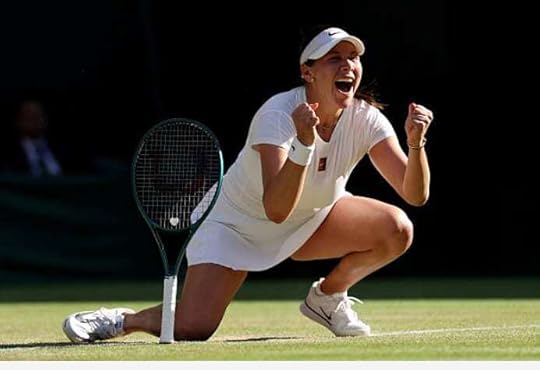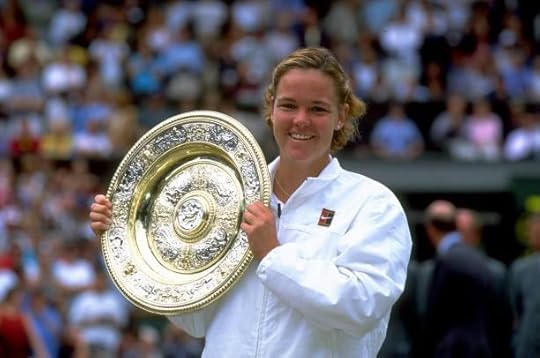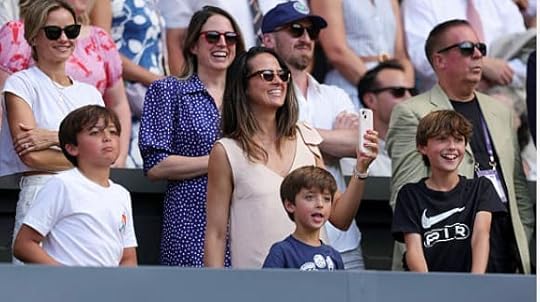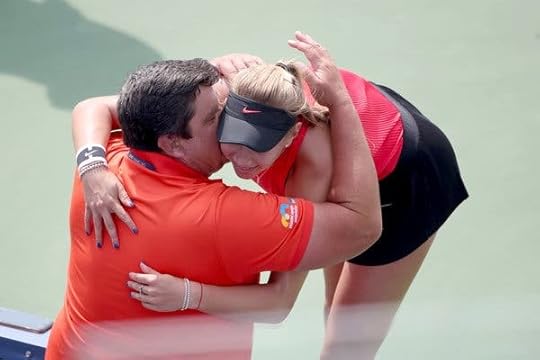Another Major Moment
 Getty
GettyWIMBLEDON – As Amanda Anisimova handled the pressure and No. 1 Aryna Sabalenka at Wimbledon to reach her first Grand Slam final, I flashed back to a time before Anisimova had played any Grand Slam tournaments.
She was 15, and I caught a plane to Miami on short notice to spend a day with her and her parents for The New York Times ahead of her trip to Paris. She had secured a reciprocal wildcard into the main draw of the 2017 French Open by doing better than her American elders in a series of spring tournaments.
I was intrigued by her precocity: She was about to become the youngest player in 12 years to compete in singles at Roland Garros.
I was intrigued by her backstory: The youngest daughter of Russian immigrant parents, she had developed her game in Florida and then decided to represent the USA instead of sticking, Sharapova-style, with Russia.
As a Springsteen fan, I was also intrigued by her birthplace: Freehold, N.J., Springsteen’s hometown, even if I soon learned that Anisimova and her family had actually lived in nearby Colts Neck.
Anisimova at 15 was tall, blonde and leggy: already 5-foot-10. Though she spoke softly and carefully, her two-handed backhand was even then a force of nature, and she was happy to share her big dreams, however sotto voce.
“I definitely want to become No. 1 in the world and win every Grand Slam,” she told me at her family’s apartment in Aventura, Fla.. “One of each would be, like, super awesome. I hope to do that one day.”
Eight years later, she is on the brink of winning her first major and guaranteed to break into the top 10 for the first time with her run at Wimbledon. It has hardly come easy. Her career has been an all-in family project from the start, and her father and longtime primary coach Konstantin died suddenly of a heart attack in August 2019 at age 52. That was a colossal blow to Anisimova, who was 17 and had just reached the semifinals of the French Open. Though she soon returned to the tour, she took an eight-month break from competition in 2023 for her mental health. She was burned out and depressed and found it “unbearable” to be at tournaments.
For the first time since starting to play at age 2, she put the racket aside and lived a more conventional existence: attending university classes in person and prioritizing friends and her social life.
Though she says now that she intended to return to the circuit, Max Eisenbud, her agent at IMG who also represents Sharapova and Li Na, was far from certain.
“When someone takes nearly a year off like that, you don’t know if they’re going to come back or want to come back or can they play at this level?” he said recently. “So, I’m very proud of her.”
“I think we’ve all known her level is top five in the world. She’s so good, It’s just all the other things around her, but just on a personal level for a client I’ve managed for a long time, I’m happy to see she’s happy. At the end of the day, that’s all you can ask for, and if she’s also winning tennis matches that’s great. And honestly, if she doesn’t want to play tennis and she’s happy, that’s good too.”
Christopher Clarey's Tennis & Beyond is a reader-supported publication. To receive new posts and support my work, consider becoming a free or paid subscriber.
It is all coming together in 2025, a season in which Anisimova won her first WTA 1000 title in Doha and has found sparkling form again on the grass, reaching the final at Queen’s Club before losing to veteran slicemeister Tatjana Maria and now getting to the title match at the Big W.A
Anisimova’s easy power, penetrating serve and relatively flat, fluid groundstrokes are a great fit for grass, just as they were for Lindsay Davenport, the towering American ball-striker supreme to whom Konstantin often compared his daughter. Like Davenport, a former No. 1 and Wimbledon champion, Anisimova will never be a speedster, but she has improved her court coverage and ability to recover quickly out of the corners.
 Davenport 1999
Davenport 1999Anisimova, still just 23, has had star coaches in her career, including Nick Saviano, Carlos Rodriguez and, for a very brief period, Darren Cahill. But she has managed this renaissance with a lower-profile team: coach Rick Vleeshouwers, strength and conditioning coach Rob Brandsma and physiotherapist Shadi Soleymani.
Brandsma worked with Anisimova before her long break from the game and returned to her team after splitting with Chinese star Zheng Qinwen last year. He recommended Vleeshouwers, who had coached Belgian stars Elise Mertens and Yannick Wickmayer. Soleymani, who worked with Zheng during her run to the Australian Open final and Olympic singles gold in 2024, joined Anisimova’s team in April.
 Instagram. Left to Right: Soleymani, Brandsma, Vleeshouwers, Anisimova
Instagram. Left to Right: Soleymani, Brandsma, Vleeshouwers, AnisimovaAll that stands between them and a first major is former No. 1 Iga Swiatek, and though Swiatek has never been this deep at Wimbledon either and has not won a title in over a year, she deserves to be the favorite. She has a 5-0 record in Grand Slam finals and has been dynamic and convincing on the grass, which has long been her least favorite surface despite her Wimbledon girls title. She is serving particularly well, holding 90 percent of the time, the best rate of any woman who reached the second week.
Though she and Anisimova have known each other for nearly a decade, they have never played on tour. They faced off only as juniors, with Swiatek defeating Anisimova in straight sets in Poland’s win over the United States in an international team competition, junior Fed Cup, in 2016.
“She was a great junior,” Anisimova said. “I remember a lot of coaches were saying that she’s going to be a big deal one day. Obviously they were right.”
Others were saying much the same about Anisimova at 15, including veteran coaches like Saviano and Martin Blackman who had seen many a prodigious prospect and learned to be cautious.
Thanks for reading Christopher Clarey's Tennis & Beyond! This post is public so feel free to share it.
“Amanda is a very special player,” said Blackman, then the general manager for player development at the United States Tennis Association.
“The ball kind of explodes off her racket,” said Saviano. “So she tends to hit a lot of winners naturally when just hitting normal groundstrokes. But she also has the will and determination to be someone who wants to be absolutely as good as they can possibly be.”
Though Anisimova’s mother Olga taught her the fundamentals until Amanda was 7, the family relied heavily for her early development on Saviano, a gifted technician who has worked with Genie Bouchard and Sloane Stephens and many others.
The Anisimovs had a clear plan, one they developed, as is often the case in tennis families, by learning from their eldest child’s career.
Amanda’s only sibling, Maria Egee, is 13 years older and played tennis in the Ivy League at the University of Pennsylvania, a remarkable feat considering that she started playing the game at age 11. She has gone on to a notable career in finance as a vice president at Goldman Sachs and a director of credit trading at Bank of America before joining Loop Capital in Miami.
 Getty/Maria Egee, at this year’s Wimbledon, is in the upper left corner
Getty/Maria Egee, at this year’s Wimbledon, is in the upper left cornerMaria and her parents moved to the United States in 1998 during a financial crisis in Russia (Konstantin told me he and his wife both worked in the banking sectors). Maria was 10 and none of the family spoke much English. Konstantin told me they had seriously considered moving to Spain but had decided at that stage in world affairs that there was more opportunity in the U.S. and more chance to truly assimilate.
“We really like Spain, but then we recognized when we visited America that everybody who comes here is going to feel like home,” he said. “In Europe, you always feel like a foreigner because it’s a completely different culture. America is a united country where people come from all over the world, and after a couple of years, they feel this is home, you know?”
Amanda was born in 2001 and was soon mimicking her much older sister’s strokes with a miniature racket as she watched from courtside. The family relocated to Florida in 2004 for the weather and to help advance Maria’s tennis career, but it was Amanda’s tennis that benefited most. She was home-schooled from an early age, and Olga started teaching tennis to other youngsters in the area in part so that Amanda would have a circle of peers.
“We didn’t want to take her whole childhood away from her,” Maria told me in an interview for the New York Times in 2020. “It was important to have regular social interactions, so mom had lessons for kids and Amanda would train on the court next to them, and all the lunch breaks and pool time and interactions after that, they would be together. Some of her best friends are still people she met at that time, but I was watching the kids and just knew Amanda was different and special. I never met anyone that age that had that work ethic and maturity level. She is also just physically very gifted.”
Maria, who sometimes served as a sparring partner, also sensed the strong will of her mother.
“You could tell she was willing to sacrifice her whole life for my sister to have this American dream, which is actually a world dream,” Maria said. “I had faith in them. Never a doubt in my mind.”
Konstantin, a strapping and expansive man, also played a crucial role. During our interviews, he seemed attuned to the pitfalls of raising a child prodigy, particularly after early success.
“I saw a lot of parents who got immediately delusional, and those stories end up in a very bad way,” he said. “You can’t overtrain. You can’t over-push.”
 Konstantin and Amanda in 2017/Getty
Konstantin and Amanda in 2017/GettyHe was intent on Amanda avoiding burnout. Sadly, it happened anyway, even though he did not live to see it. He and Olga separated in 2018 but remained on good terms, according to Maria. He died at their home in Aventura when Amanda was in New York preparing for the 2019 US Open with Olga.
Amanda withdrew from the Open, and I traveled to Florida again later that year to meet with her ahead of the 2020 season.
“This is obviously the hardest thing I’ve had to go through and the hardest thing that’s ever happened to me, and I don’t really talk about it with anyone,” she said then. “The only thing that has helped me is just playing tennis and being on the court. That’s what makes me happy, and I know it would make him happy, so that’s the way it is.”
At that stage, she was already a Grand Slam semifinalist, losing to Ashleigh Barty in Paris in 2019. It has taken another six years for Anisimova to go one step further at a major, and it has been poignant to watch her not only fulfilling her potential at Wimbledon but reveling in it: beaming in the sunshine or tumbling to the grass after her nervy victory over Anastasia Pavlyuchenkova in the quarterfinals and then celebrating with Maria’s young son Jackson in tow.
“When I took my break, a lot of people told me that you would never make it to the top again if you take so much time away from the game,” Anisimova said. “That was a little hard to digest, because I did want to come back and still achieve a lot and win a Grand Slam one day. Just me being able to prove that you can get back to the top if you prioritize yourself, that's been incredibly special to me.”
CC

Christopher Clarey's Blog
- Christopher Clarey's profile
- 31 followers



